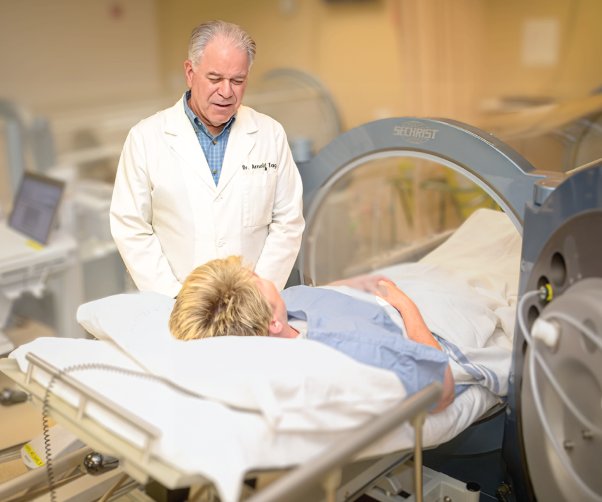
Optimized Healing: Wound Care at Home and Hyperbaric Oxygen Therapy
If you’re living with a chronic or hard-to-heal wound, hyperbaric oxygen therapy may help. This treatment increases the oxygen level in your body to aid in healing wounds. It’s often used alongside other clinic-based treatments or traditional wound care at home.
How Hyperbaric Oxygen Therapy Works
Wounds that aren't treated properly or don’t heal can lead to:
- Amputation
- Decreased quality of life
- Difficulty doing everyday tasks
- Increased pain
- Serious infections
“Hyperbaric oxygen therapy is a leading-edge wound care treatment that’s often used with other conventional treatments,” says Tonya Rountree, MSN, RN, director of wound care at Methodist North Hospital. “It’s typically done in a hospital or outpatient wound care center and can promote healing in hard-to-heal wounds.”
During hyperbaric oxygen therapy, the patient lies or sits in a pressurized chamber filled with 100% oxygen. Regular air is about 21% oxygen by comparison. Breathing in more oxygen increases the oxygen level in the blood, which can help wounds heal faster and more effectively. Oxygen can also:
- Decrease excess fluid and swelling
- Encourage the growth of new blood vessels in the area
- Improve blood flow to promote wound healing
- Preserve healthy tissue around the wound
- Provide antibacterial effects
- Reduce the risk of infection
Hyperbaric Oxygen Therapy for Wound Care
Hyperbaric oxygen therapy may be beneficial when other wound care options haven’t been successful or the wound heals slower than expected after 30 days of standard therapy. It’s also used to treat severe skin and soft tissue injuries.
You may benefit from hyperbaric oxygen therapy if you have one of these types of wounds:
- Actinomycosis: a chronic bacterial infection that typically affects the face or neck
- Chronic refractory osteomyelitis: a bone infection that may lead to skin and other soft-tissue damage
- Diabetic wounds: hard-to-heal wounds that often appear on the feet or legs
- Gas gangrene: a bacterial infection that typically develops in surgical wounds or after trauma damages skin
- Osteoradionecrosis: damage to the soft tissue in the jaw due to radiation therapy
- Progressive necrotizing infections: severe bacterial infections that break down the skin
- Skin grafts that are not healing well
- Soft-tissue radionecrosis: soft-tissue breakdown due to poor blood flow caused by radiation therapy
“Hyperbaric oxygen therapy is generally safe, but it isn’t a good fit for everyone,” Rountree says. “Before starting treatment, let your provider know if you’re pregnant, have a history of sinus issues or seizures, or have a pacemaker or other implanted device.”
SUBSCRIBE TO OUR BLOG
and you'll receive more health & wellness tips right in your inbox.
SUBSCRIBE NOWPost-Treatment Wound Care at Home
Your care team will work with you to develop a treatment plan to meet your unique needs. This may include additional outpatient wound care services, home healthcare, at-home wound care or a combination of these. If you qualify, Medicare or Medicaid may cover nursing services for wound care at home in combination with outpatient hyperbaric oxygen therapy.
If your care team recommends at-home treatment for your wounds, they will teach you how to clean the wound and educate you on how to prevent infection. They may also give you tips on chronic wound management to prevent a wound from worsening.
“Learning the signs of infection can help address wound care concerns as early as possible,” Rountree says. “Let your care team know right away if you have a fever if the area around the wound is hot to the touch, or if you notice a significant increase in drainage, foul odors, pain, redness or swelling near your wound.”
If your care team does not recommend at-home treatment for your wounds, do not attempt it.
Proactive Ways to Promote Wound Healing
Your overall health and other health conditions affect how well your body can heal wounds. You can help promote wound healing by:
- Avoiding tobacco use or quitting smoking
- Eating a healthy, well-balanced diet
- Drinking plenty of water throughout the day — if you have fluid restrictions, speak with your provider before drinking more water
- Following your wound care team’s instructions on caring for your wound
- Keeping pressure off the wound
- Managing chronic health conditions, such as diabetes and high blood pressure
- Maintaining a healthy blood sugar level
- Staying as active as possible
- Taking all medications as directed, even if you're feeling better
- Wearing shoes any time you’re out of bed
If your wound is on your leg or foot, ask your care team if compression stockings, elevating your leg or wearing shoes that offload pressure may help. It can also be useful to talk with your care team about ways to help prevent wounds in the future.
Leading-Edge Wound Healing Is Just Around the Corner
Interested in learning more about hyperbaric oxygen therapy for wound care? The Wound Healing Centers at Methodist South Hospital and Methodist North Hospital are ready to welcome you.
Related Articles


